The Role of Hybrid ECM in Modern Business Content Management
VerifiedAdded on 2020/03/16
|9
|1958
|180
Report
AI Summary
This report provides a comprehensive overview of Hybrid Enterprise Content Management (ECM), exploring the integration of cloud-based services with on-premises software for managing enterprise content. It delves into various aspects of storing information in the cloud, the use of ECM applications, and the drivers behind hybrid ECM deployments, such as cost, mobility, and new features. The report highlights the advantages of adopting a cloud approach to content management, including reduced hardware and IT expenses, improved mobility, and enhanced collaboration. It also acknowledges the disadvantages, such as potential complications with configuration and enterprise search interoperability. The report references several studies and publications to support its analysis, ultimately providing a balanced perspective on the benefits and challenges of hybrid ECM in modern business environments.

Report
Student Name
Institute Name
Student Name
Institute Name
Paraphrase This Document
Need a fresh take? Get an instant paraphrase of this document with our AI Paraphraser
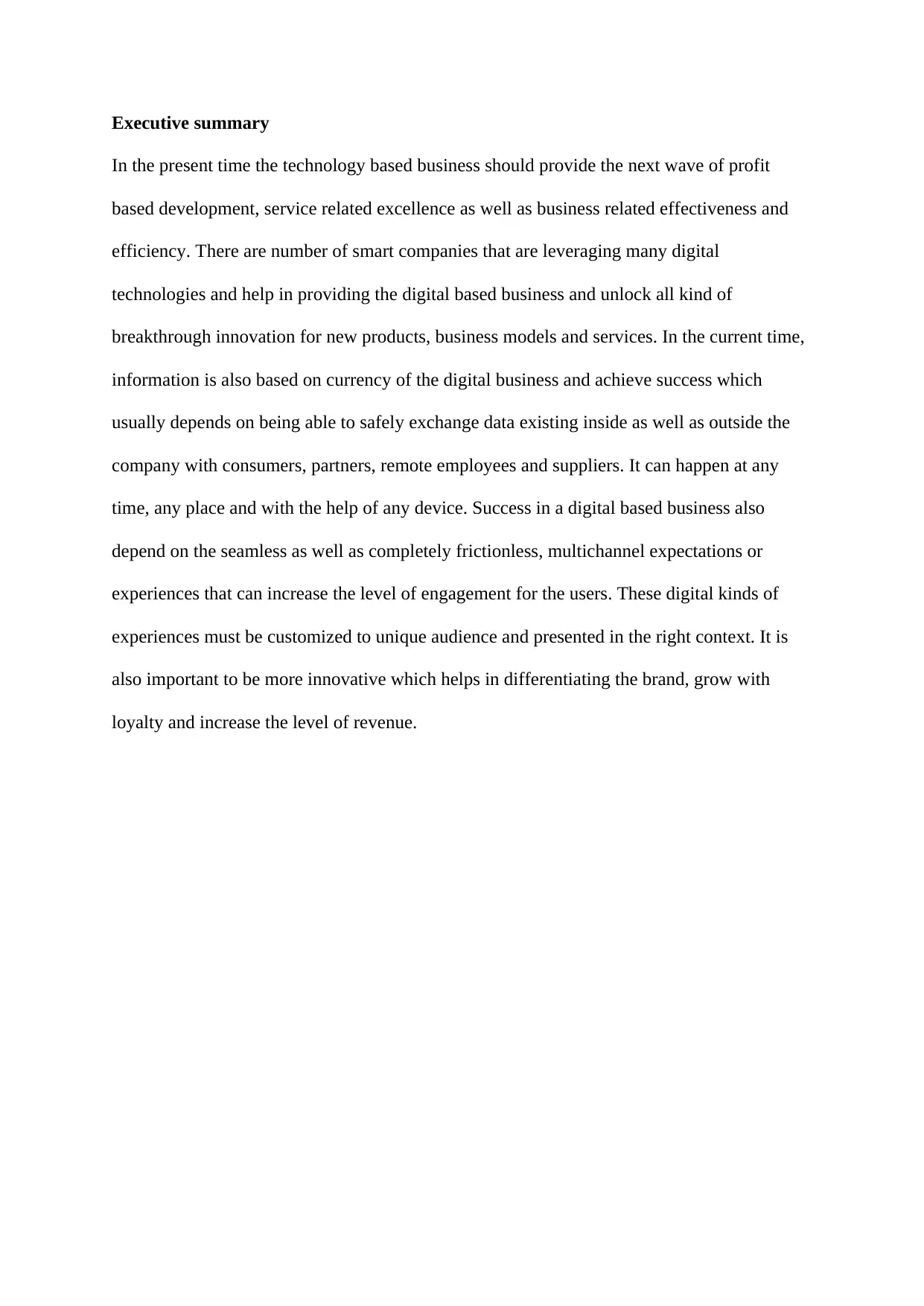
Executive summary
In the present time the technology based business should provide the next wave of profit
based development, service related excellence as well as business related effectiveness and
efficiency. There are number of smart companies that are leveraging many digital
technologies and help in providing the digital based business and unlock all kind of
breakthrough innovation for new products, business models and services. In the current time,
information is also based on currency of the digital business and achieve success which
usually depends on being able to safely exchange data existing inside as well as outside the
company with consumers, partners, remote employees and suppliers. It can happen at any
time, any place and with the help of any device. Success in a digital based business also
depend on the seamless as well as completely frictionless, multichannel expectations or
experiences that can increase the level of engagement for the users. These digital kinds of
experiences must be customized to unique audience and presented in the right context. It is
also important to be more innovative which helps in differentiating the brand, grow with
loyalty and increase the level of revenue.
In the present time the technology based business should provide the next wave of profit
based development, service related excellence as well as business related effectiveness and
efficiency. There are number of smart companies that are leveraging many digital
technologies and help in providing the digital based business and unlock all kind of
breakthrough innovation for new products, business models and services. In the current time,
information is also based on currency of the digital business and achieve success which
usually depends on being able to safely exchange data existing inside as well as outside the
company with consumers, partners, remote employees and suppliers. It can happen at any
time, any place and with the help of any device. Success in a digital based business also
depend on the seamless as well as completely frictionless, multichannel expectations or
experiences that can increase the level of engagement for the users. These digital kinds of
experiences must be customized to unique audience and presented in the right context. It is
also important to be more innovative which helps in differentiating the brand, grow with
loyalty and increase the level of revenue.
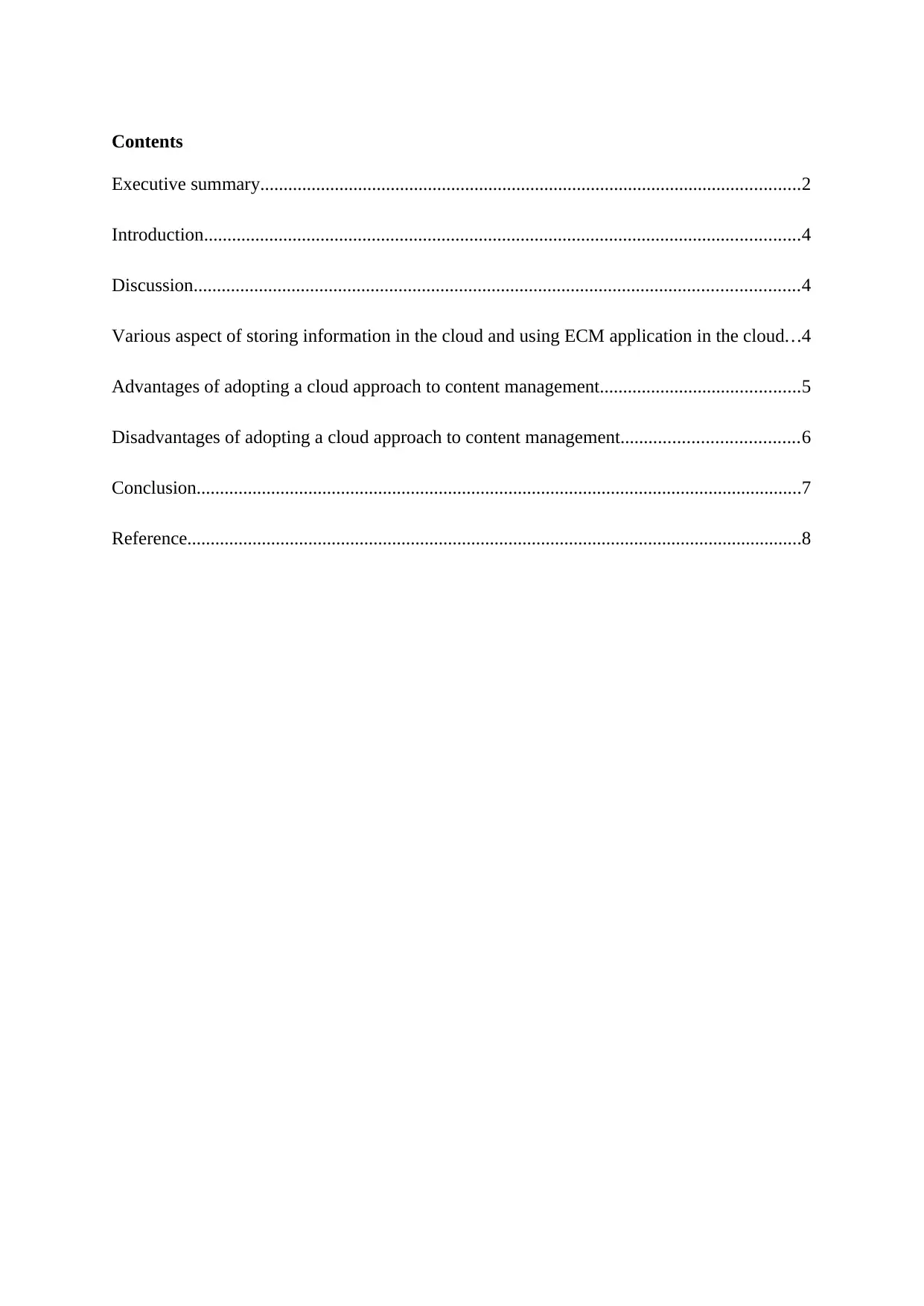
Contents
Executive summary....................................................................................................................2
Introduction................................................................................................................................4
Discussion..................................................................................................................................4
Various aspect of storing information in the cloud and using ECM application in the cloud...4
Advantages of adopting a cloud approach to content management...........................................5
Disadvantages of adopting a cloud approach to content management......................................6
Conclusion..................................................................................................................................7
Reference....................................................................................................................................8
Executive summary....................................................................................................................2
Introduction................................................................................................................................4
Discussion..................................................................................................................................4
Various aspect of storing information in the cloud and using ECM application in the cloud...4
Advantages of adopting a cloud approach to content management...........................................5
Disadvantages of adopting a cloud approach to content management......................................6
Conclusion..................................................................................................................................7
Reference....................................................................................................................................8
⊘ This is a preview!⊘
Do you want full access?
Subscribe today to unlock all pages.

Trusted by 1+ million students worldwide
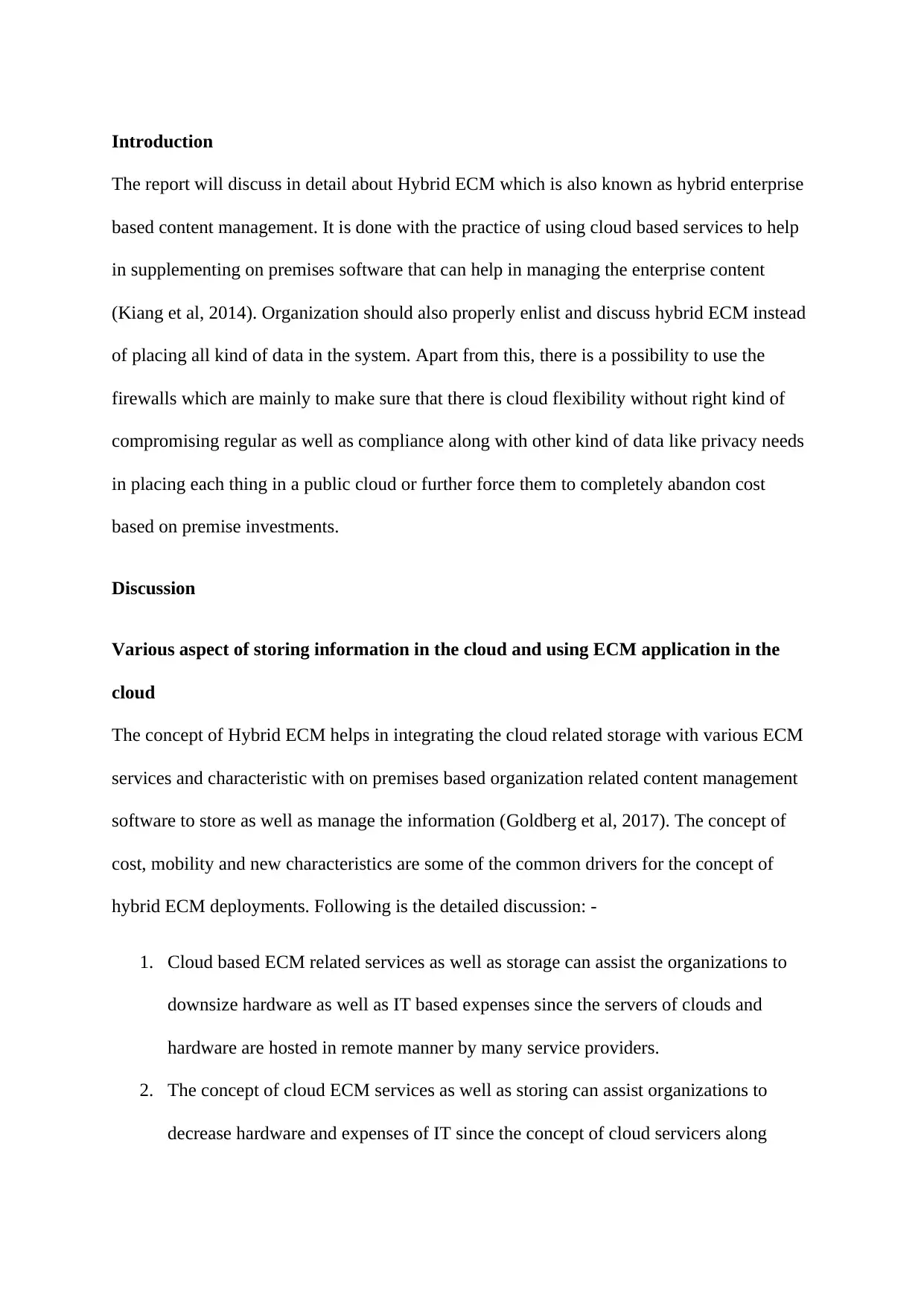
Introduction
The report will discuss in detail about Hybrid ECM which is also known as hybrid enterprise
based content management. It is done with the practice of using cloud based services to help
in supplementing on premises software that can help in managing the enterprise content
(Kiang et al, 2014). Organization should also properly enlist and discuss hybrid ECM instead
of placing all kind of data in the system. Apart from this, there is a possibility to use the
firewalls which are mainly to make sure that there is cloud flexibility without right kind of
compromising regular as well as compliance along with other kind of data like privacy needs
in placing each thing in a public cloud or further force them to completely abandon cost
based on premise investments.
Discussion
Various aspect of storing information in the cloud and using ECM application in the
cloud
The concept of Hybrid ECM helps in integrating the cloud related storage with various ECM
services and characteristic with on premises based organization related content management
software to store as well as manage the information (Goldberg et al, 2017). The concept of
cost, mobility and new characteristics are some of the common drivers for the concept of
hybrid ECM deployments. Following is the detailed discussion: -
1. Cloud based ECM related services as well as storage can assist the organizations to
downsize hardware as well as IT based expenses since the servers of clouds and
hardware are hosted in remote manner by many service providers.
2. The concept of cloud ECM services as well as storing can assist organizations to
decrease hardware and expenses of IT since the concept of cloud servicers along
The report will discuss in detail about Hybrid ECM which is also known as hybrid enterprise
based content management. It is done with the practice of using cloud based services to help
in supplementing on premises software that can help in managing the enterprise content
(Kiang et al, 2014). Organization should also properly enlist and discuss hybrid ECM instead
of placing all kind of data in the system. Apart from this, there is a possibility to use the
firewalls which are mainly to make sure that there is cloud flexibility without right kind of
compromising regular as well as compliance along with other kind of data like privacy needs
in placing each thing in a public cloud or further force them to completely abandon cost
based on premise investments.
Discussion
Various aspect of storing information in the cloud and using ECM application in the
cloud
The concept of Hybrid ECM helps in integrating the cloud related storage with various ECM
services and characteristic with on premises based organization related content management
software to store as well as manage the information (Goldberg et al, 2017). The concept of
cost, mobility and new characteristics are some of the common drivers for the concept of
hybrid ECM deployments. Following is the detailed discussion: -
1. Cloud based ECM related services as well as storage can assist the organizations to
downsize hardware as well as IT based expenses since the servers of clouds and
hardware are hosted in remote manner by many service providers.
2. The concept of cloud ECM services as well as storing can assist organizations to
decrease hardware and expenses of IT since the concept of cloud servicers along
Paraphrase This Document
Need a fresh take? Get an instant paraphrase of this document with our AI Paraphraser
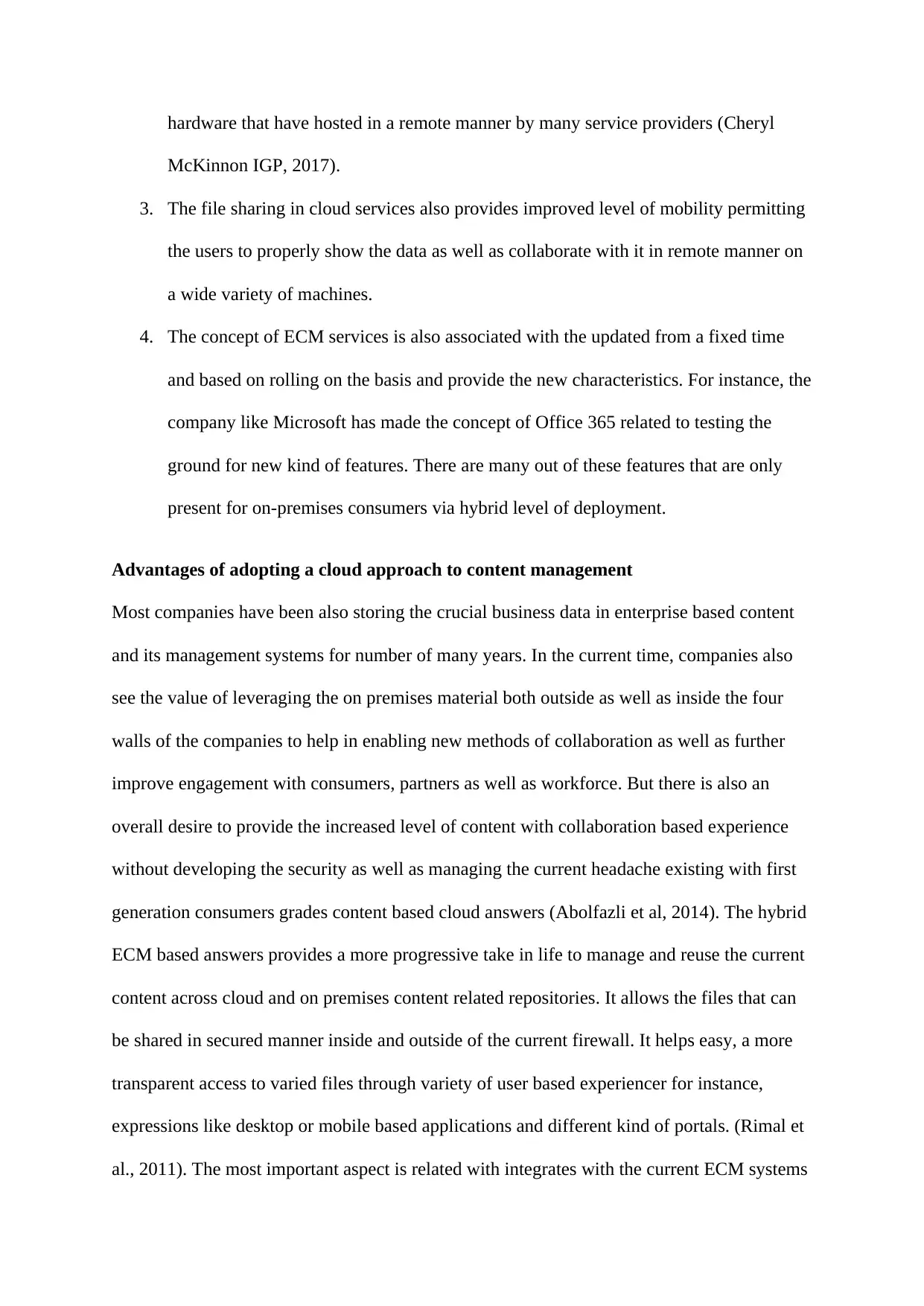
hardware that have hosted in a remote manner by many service providers (Cheryl
McKinnon IGP, 2017).
3. The file sharing in cloud services also provides improved level of mobility permitting
the users to properly show the data as well as collaborate with it in remote manner on
a wide variety of machines.
4. The concept of ECM services is also associated with the updated from a fixed time
and based on rolling on the basis and provide the new characteristics. For instance, the
company like Microsoft has made the concept of Office 365 related to testing the
ground for new kind of features. There are many out of these features that are only
present for on-premises consumers via hybrid level of deployment.
Advantages of adopting a cloud approach to content management
Most companies have been also storing the crucial business data in enterprise based content
and its management systems for number of many years. In the current time, companies also
see the value of leveraging the on premises material both outside as well as inside the four
walls of the companies to help in enabling new methods of collaboration as well as further
improve engagement with consumers, partners as well as workforce. But there is also an
overall desire to provide the increased level of content with collaboration based experience
without developing the security as well as managing the current headache existing with first
generation consumers grades content based cloud answers (Abolfazli et al, 2014). The hybrid
ECM based answers provides a more progressive take in life to manage and reuse the current
content across cloud and on premises content related repositories. It allows the files that can
be shared in secured manner inside and outside of the current firewall. It helps easy, a more
transparent access to varied files through variety of user based experiencer for instance,
expressions like desktop or mobile based applications and different kind of portals. (Rimal et
al., 2011). The most important aspect is related with integrates with the current ECM systems
McKinnon IGP, 2017).
3. The file sharing in cloud services also provides improved level of mobility permitting
the users to properly show the data as well as collaborate with it in remote manner on
a wide variety of machines.
4. The concept of ECM services is also associated with the updated from a fixed time
and based on rolling on the basis and provide the new characteristics. For instance, the
company like Microsoft has made the concept of Office 365 related to testing the
ground for new kind of features. There are many out of these features that are only
present for on-premises consumers via hybrid level of deployment.
Advantages of adopting a cloud approach to content management
Most companies have been also storing the crucial business data in enterprise based content
and its management systems for number of many years. In the current time, companies also
see the value of leveraging the on premises material both outside as well as inside the four
walls of the companies to help in enabling new methods of collaboration as well as further
improve engagement with consumers, partners as well as workforce. But there is also an
overall desire to provide the increased level of content with collaboration based experience
without developing the security as well as managing the current headache existing with first
generation consumers grades content based cloud answers (Abolfazli et al, 2014). The hybrid
ECM based answers provides a more progressive take in life to manage and reuse the current
content across cloud and on premises content related repositories. It allows the files that can
be shared in secured manner inside and outside of the current firewall. It helps easy, a more
transparent access to varied files through variety of user based experiencer for instance,
expressions like desktop or mobile based applications and different kind of portals. (Rimal et
al., 2011). The most important aspect is related with integrates with the current ECM systems
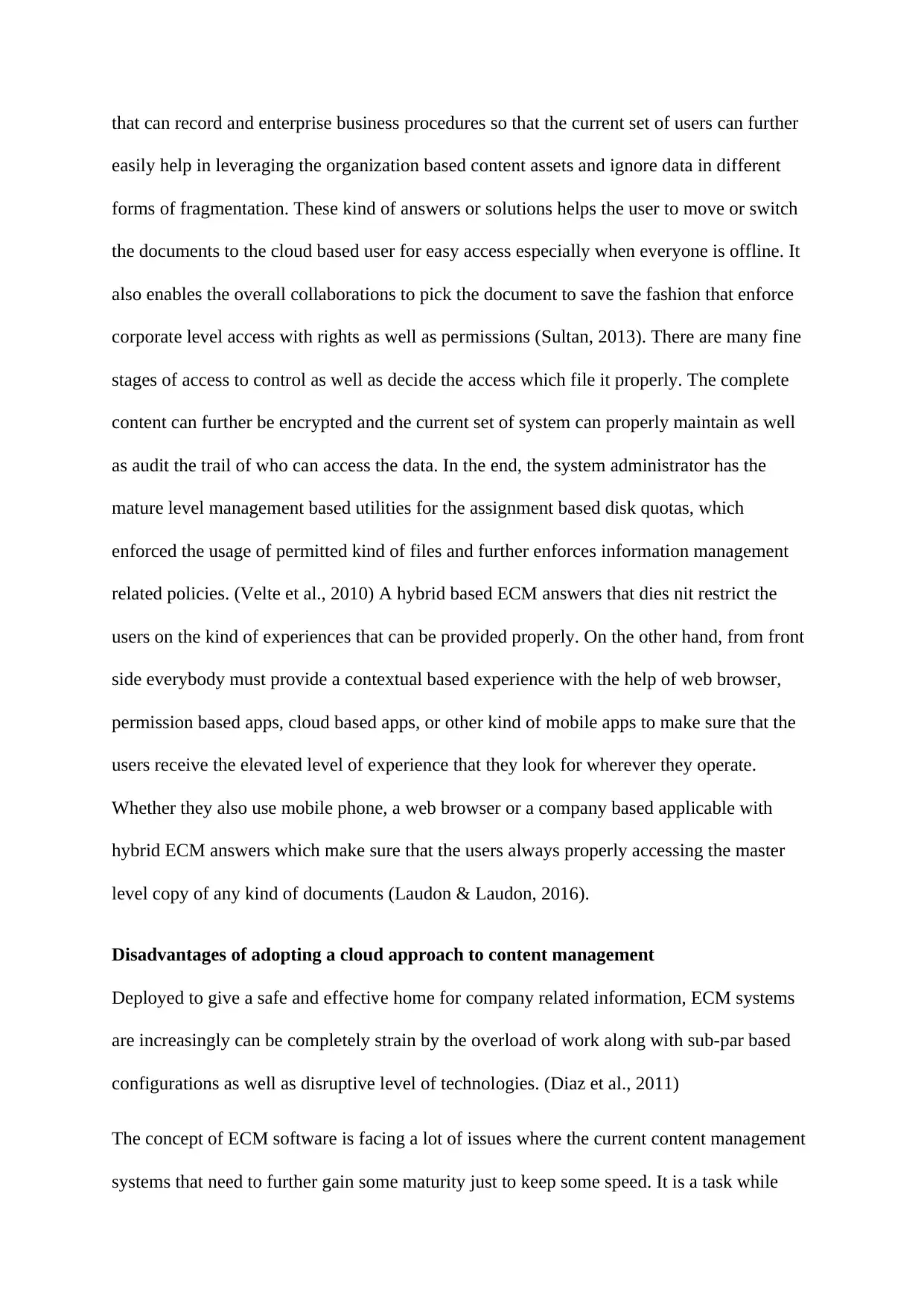
that can record and enterprise business procedures so that the current set of users can further
easily help in leveraging the organization based content assets and ignore data in different
forms of fragmentation. These kind of answers or solutions helps the user to move or switch
the documents to the cloud based user for easy access especially when everyone is offline. It
also enables the overall collaborations to pick the document to save the fashion that enforce
corporate level access with rights as well as permissions (Sultan, 2013). There are many fine
stages of access to control as well as decide the access which file it properly. The complete
content can further be encrypted and the current set of system can properly maintain as well
as audit the trail of who can access the data. In the end, the system administrator has the
mature level management based utilities for the assignment based disk quotas, which
enforced the usage of permitted kind of files and further enforces information management
related policies. (Velte et al., 2010) A hybrid based ECM answers that dies nit restrict the
users on the kind of experiences that can be provided properly. On the other hand, from front
side everybody must provide a contextual based experience with the help of web browser,
permission based apps, cloud based apps, or other kind of mobile apps to make sure that the
users receive the elevated level of experience that they look for wherever they operate.
Whether they also use mobile phone, a web browser or a company based applicable with
hybrid ECM answers which make sure that the users always properly accessing the master
level copy of any kind of documents (Laudon & Laudon, 2016).
Disadvantages of adopting a cloud approach to content management
Deployed to give a safe and effective home for company related information, ECM systems
are increasingly can be completely strain by the overload of work along with sub-par based
configurations as well as disruptive level of technologies. (Diaz et al., 2011)
The concept of ECM software is facing a lot of issues where the current content management
systems that need to further gain some maturity just to keep some speed. It is a task while
easily help in leveraging the organization based content assets and ignore data in different
forms of fragmentation. These kind of answers or solutions helps the user to move or switch
the documents to the cloud based user for easy access especially when everyone is offline. It
also enables the overall collaborations to pick the document to save the fashion that enforce
corporate level access with rights as well as permissions (Sultan, 2013). There are many fine
stages of access to control as well as decide the access which file it properly. The complete
content can further be encrypted and the current set of system can properly maintain as well
as audit the trail of who can access the data. In the end, the system administrator has the
mature level management based utilities for the assignment based disk quotas, which
enforced the usage of permitted kind of files and further enforces information management
related policies. (Velte et al., 2010) A hybrid based ECM answers that dies nit restrict the
users on the kind of experiences that can be provided properly. On the other hand, from front
side everybody must provide a contextual based experience with the help of web browser,
permission based apps, cloud based apps, or other kind of mobile apps to make sure that the
users receive the elevated level of experience that they look for wherever they operate.
Whether they also use mobile phone, a web browser or a company based applicable with
hybrid ECM answers which make sure that the users always properly accessing the master
level copy of any kind of documents (Laudon & Laudon, 2016).
Disadvantages of adopting a cloud approach to content management
Deployed to give a safe and effective home for company related information, ECM systems
are increasingly can be completely strain by the overload of work along with sub-par based
configurations as well as disruptive level of technologies. (Diaz et al., 2011)
The concept of ECM software is facing a lot of issues where the current content management
systems that need to further gain some maturity just to keep some speed. It is a task while
⊘ This is a preview!⊘
Do you want full access?
Subscribe today to unlock all pages.

Trusted by 1+ million students worldwide
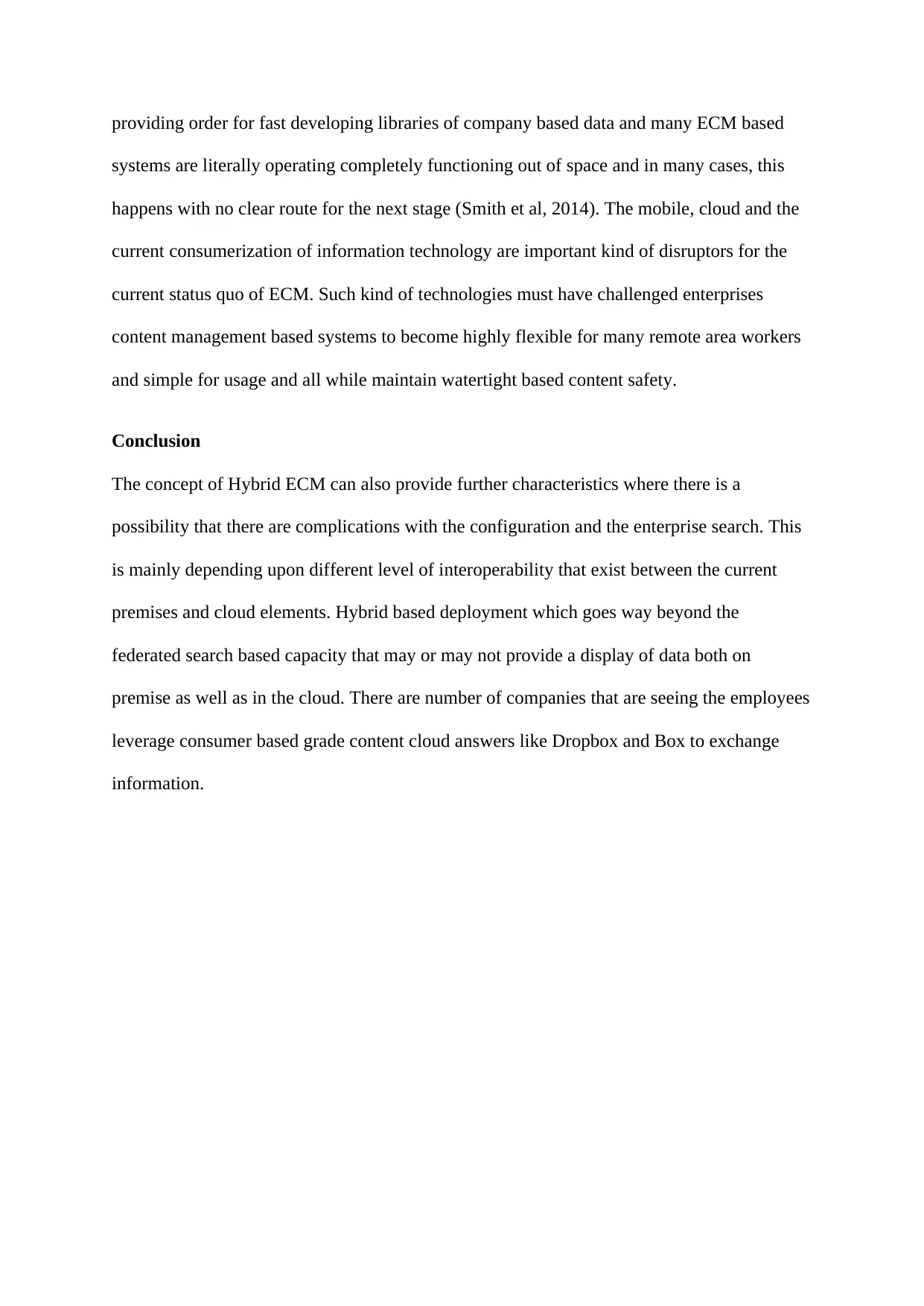
providing order for fast developing libraries of company based data and many ECM based
systems are literally operating completely functioning out of space and in many cases, this
happens with no clear route for the next stage (Smith et al, 2014). The mobile, cloud and the
current consumerization of information technology are important kind of disruptors for the
current status quo of ECM. Such kind of technologies must have challenged enterprises
content management based systems to become highly flexible for many remote area workers
and simple for usage and all while maintain watertight based content safety.
Conclusion
The concept of Hybrid ECM can also provide further characteristics where there is a
possibility that there are complications with the configuration and the enterprise search. This
is mainly depending upon different level of interoperability that exist between the current
premises and cloud elements. Hybrid based deployment which goes way beyond the
federated search based capacity that may or may not provide a display of data both on
premise as well as in the cloud. There are number of companies that are seeing the employees
leverage consumer based grade content cloud answers like Dropbox and Box to exchange
information.
systems are literally operating completely functioning out of space and in many cases, this
happens with no clear route for the next stage (Smith et al, 2014). The mobile, cloud and the
current consumerization of information technology are important kind of disruptors for the
current status quo of ECM. Such kind of technologies must have challenged enterprises
content management based systems to become highly flexible for many remote area workers
and simple for usage and all while maintain watertight based content safety.
Conclusion
The concept of Hybrid ECM can also provide further characteristics where there is a
possibility that there are complications with the configuration and the enterprise search. This
is mainly depending upon different level of interoperability that exist between the current
premises and cloud elements. Hybrid based deployment which goes way beyond the
federated search based capacity that may or may not provide a display of data both on
premise as well as in the cloud. There are number of companies that are seeing the employees
leverage consumer based grade content cloud answers like Dropbox and Box to exchange
information.
Paraphrase This Document
Need a fresh take? Get an instant paraphrase of this document with our AI Paraphraser
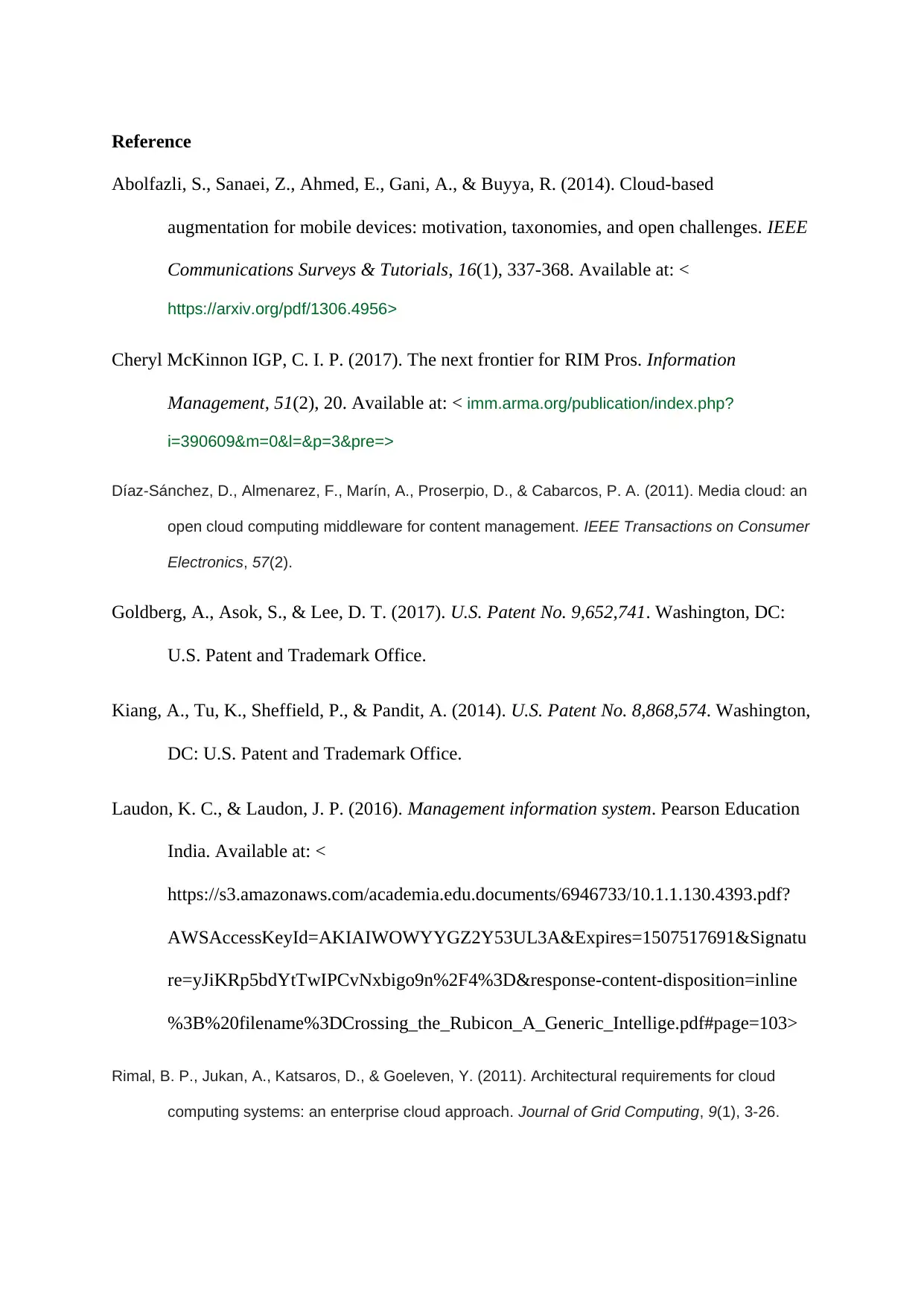
Reference
Abolfazli, S., Sanaei, Z., Ahmed, E., Gani, A., & Buyya, R. (2014). Cloud-based
augmentation for mobile devices: motivation, taxonomies, and open challenges. IEEE
Communications Surveys & Tutorials, 16(1), 337-368. Available at: <
https://arxiv.org/pdf/1306.4956>
Cheryl McKinnon IGP, C. I. P. (2017). The next frontier for RIM Pros. Information
Management, 51(2), 20. Available at: < imm.arma.org/publication/index.php?
i=390609&m=0&l=&p=3&pre=>
Díaz-Sánchez, D., Almenarez, F., Marín, A., Proserpio, D., & Cabarcos, P. A. (2011). Media cloud: an
open cloud computing middleware for content management. IEEE Transactions on Consumer
Electronics, 57(2).
Goldberg, A., Asok, S., & Lee, D. T. (2017). U.S. Patent No. 9,652,741. Washington, DC:
U.S. Patent and Trademark Office.
Kiang, A., Tu, K., Sheffield, P., & Pandit, A. (2014). U.S. Patent No. 8,868,574. Washington,
DC: U.S. Patent and Trademark Office.
Laudon, K. C., & Laudon, J. P. (2016). Management information system. Pearson Education
India. Available at: <
https://s3.amazonaws.com/academia.edu.documents/6946733/10.1.1.130.4393.pdf?
AWSAccessKeyId=AKIAIWOWYYGZ2Y53UL3A&Expires=1507517691&Signatu
re=yJiKRp5bdYtTwIPCvNxbigo9n%2F4%3D&response-content-disposition=inline
%3B%20filename%3DCrossing_the_Rubicon_A_Generic_Intellige.pdf#page=103>
Rimal, B. P., Jukan, A., Katsaros, D., & Goeleven, Y. (2011). Architectural requirements for cloud
computing systems: an enterprise cloud approach. Journal of Grid Computing, 9(1), 3-26.
Abolfazli, S., Sanaei, Z., Ahmed, E., Gani, A., & Buyya, R. (2014). Cloud-based
augmentation for mobile devices: motivation, taxonomies, and open challenges. IEEE
Communications Surveys & Tutorials, 16(1), 337-368. Available at: <
https://arxiv.org/pdf/1306.4956>
Cheryl McKinnon IGP, C. I. P. (2017). The next frontier for RIM Pros. Information
Management, 51(2), 20. Available at: < imm.arma.org/publication/index.php?
i=390609&m=0&l=&p=3&pre=>
Díaz-Sánchez, D., Almenarez, F., Marín, A., Proserpio, D., & Cabarcos, P. A. (2011). Media cloud: an
open cloud computing middleware for content management. IEEE Transactions on Consumer
Electronics, 57(2).
Goldberg, A., Asok, S., & Lee, D. T. (2017). U.S. Patent No. 9,652,741. Washington, DC:
U.S. Patent and Trademark Office.
Kiang, A., Tu, K., Sheffield, P., & Pandit, A. (2014). U.S. Patent No. 8,868,574. Washington,
DC: U.S. Patent and Trademark Office.
Laudon, K. C., & Laudon, J. P. (2016). Management information system. Pearson Education
India. Available at: <
https://s3.amazonaws.com/academia.edu.documents/6946733/10.1.1.130.4393.pdf?
AWSAccessKeyId=AKIAIWOWYYGZ2Y53UL3A&Expires=1507517691&Signatu
re=yJiKRp5bdYtTwIPCvNxbigo9n%2F4%3D&response-content-disposition=inline
%3B%20filename%3DCrossing_the_Rubicon_A_Generic_Intellige.pdf#page=103>
Rimal, B. P., Jukan, A., Katsaros, D., & Goeleven, Y. (2011). Architectural requirements for cloud
computing systems: an enterprise cloud approach. Journal of Grid Computing, 9(1), 3-26.
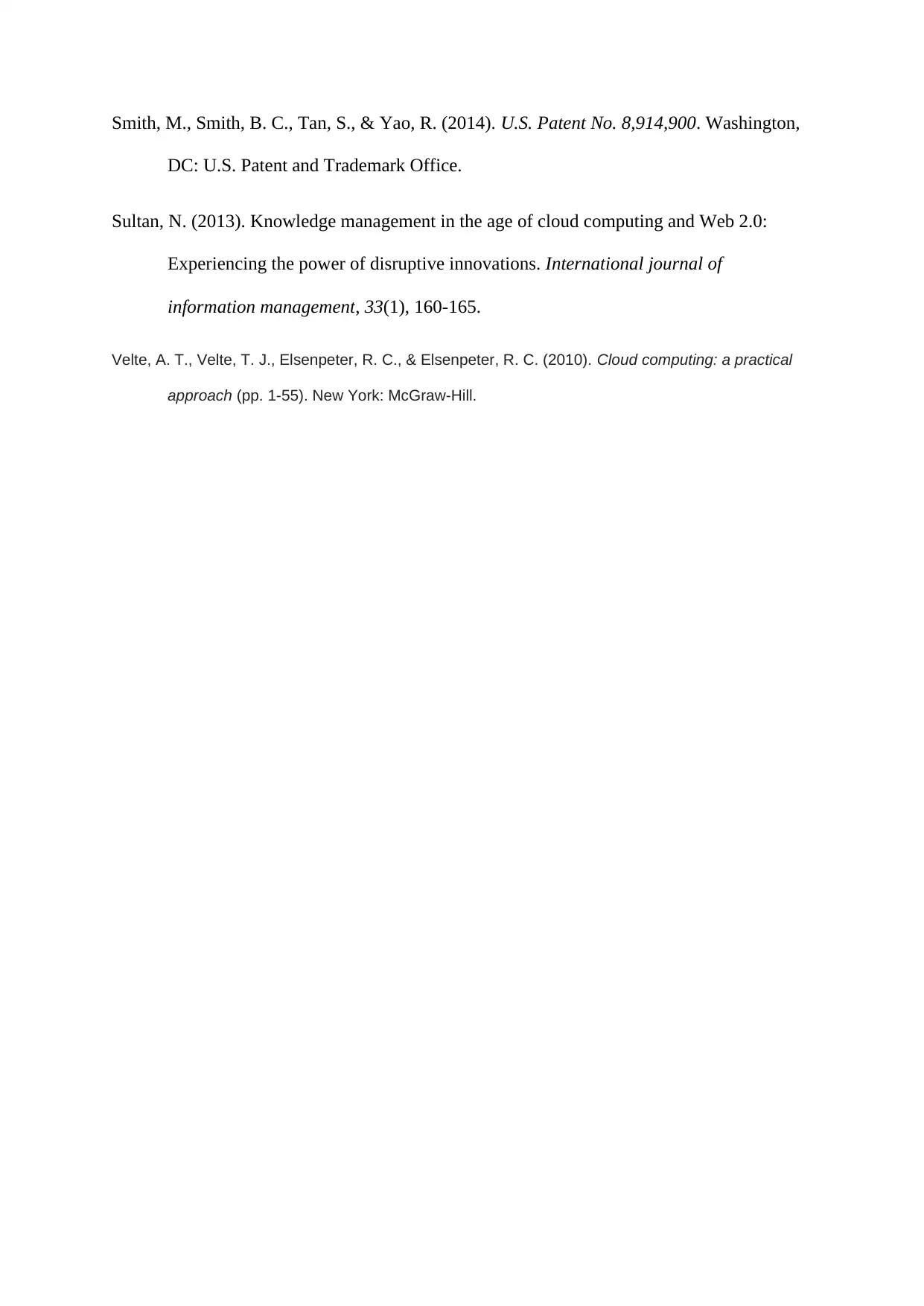
Smith, M., Smith, B. C., Tan, S., & Yao, R. (2014). U.S. Patent No. 8,914,900. Washington,
DC: U.S. Patent and Trademark Office.
Sultan, N. (2013). Knowledge management in the age of cloud computing and Web 2.0:
Experiencing the power of disruptive innovations. International journal of
information management, 33(1), 160-165.
Velte, A. T., Velte, T. J., Elsenpeter, R. C., & Elsenpeter, R. C. (2010). Cloud computing: a practical
approach (pp. 1-55). New York: McGraw-Hill.
DC: U.S. Patent and Trademark Office.
Sultan, N. (2013). Knowledge management in the age of cloud computing and Web 2.0:
Experiencing the power of disruptive innovations. International journal of
information management, 33(1), 160-165.
Velte, A. T., Velte, T. J., Elsenpeter, R. C., & Elsenpeter, R. C. (2010). Cloud computing: a practical
approach (pp. 1-55). New York: McGraw-Hill.
⊘ This is a preview!⊘
Do you want full access?
Subscribe today to unlock all pages.

Trusted by 1+ million students worldwide
1 out of 9
Related Documents
Your All-in-One AI-Powered Toolkit for Academic Success.
+13062052269
info@desklib.com
Available 24*7 on WhatsApp / Email
![[object Object]](/_next/static/media/star-bottom.7253800d.svg)
Unlock your academic potential
Copyright © 2020–2025 A2Z Services. All Rights Reserved. Developed and managed by ZUCOL.





